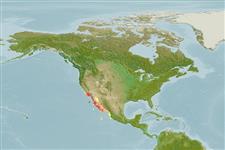>
Perciformes/Serranoidei (Groupers) >
Serranidae (Sea basses: groupers and fairy basslets)
Etymology: Paralabrax: Greek, para = the side of + Greek, labrax, -akos = a fish, Dicentrarchus labrax (Ref. 45335).
More on author: Girard.
Environment: milieu / climate zone / depth range / distribution range
Écologie
marin récifal; profondeur 1 - 183 m (Ref. 2850), usually ? - 30 m (Ref. 9324). Subtropical; 37°N - 16°N, 123°W - 99°W
Eastern Pacific: ranges from Santa Cruz in central California, USA to Magdalena Bay, Baja California. Also appears in front of Acapulco, Mexico (Ref. 9342).
Taille / Poids / Âge
Maturity: Lm ? range ? - ? cm
Max length : 67.0 cm TL mâle / non sexé; (Ref. 40637); poids max. publié: 6.0 kg (Ref. 40637); âge max. reporté: 31 années (Ref. 56049)
Usually found on sand bottom among or near rocks from shallow areas to about 183 m depth, but usually at less than 30 m. Juvenile feed on benthic invertebrates (crabs, bivalves and mysids) and rarely fish; adults prey on fishes (especially Porichthys notatus) and also on crustaceans (Ref. 9342). Pelagic spawners (Ref. 56049). Important game fish (Ref. 9342).
Pelagic spawner (Ref. 56049).
Eschmeyer, W.N., E.S. Herald and H. Hammann, 1983. A field guide to Pacific coast fishes of North America. Boston (MA, USA): Houghton Mifflin Company. xii+336 p. (Ref. 2850)
Statut dans la liste rouge de l'IUCN (Ref. 130435: Version 2024-2)
Menace pour l'homme
Harmless
Utilisations par l'homme
Pêcheries: pêcheries vivrières; pêche sportive: oui
Outils
Articles particuliers
Télécharger en XML
Sources Internet
Estimates based on models
Preferred temperature (Ref.
123201): 19.4 - 26, mean 22.3 °C (based on 16 cells).
Phylogenetic diversity index (Ref.
82804): PD
50 = 0.5020 [Uniqueness, from 0.5 = low to 2.0 = high].
Bayesian length-weight: a=0.01148 (0.00478 - 0.02756), b=3.05 (2.88 - 3.22), in cm total length, based on LWR estimates for this Genus-body shape (Ref.
93245).
Niveau trophique (Ref.
69278): 3.5 ±0.54 se; based on food items.
Résilience (Ref.
120179): Milieu, temps minimum de doublement de population : 1,4 à 4,4 années (tm=3.5; tmax=31).
Fishing Vulnerability (Ref.
59153): Moderate to high vulnerability (47 of 100).
Nutrients (Ref.
124155): Calcium = 16.9 [9.5, 39.4] mg/100g; Iron = 0.475 [0.247, 0.822] mg/100g; Protein = 19.1 [17.3, 20.8] %; Omega3 = 0.226 [0.136, 0.382] g/100g; Selenium = 22.5 [11.7, 41.9] μg/100g; VitaminA = 43 [14, 145] μg/100g; Zinc = 0.675 [0.452, 1.012] mg/100g (wet weight);
